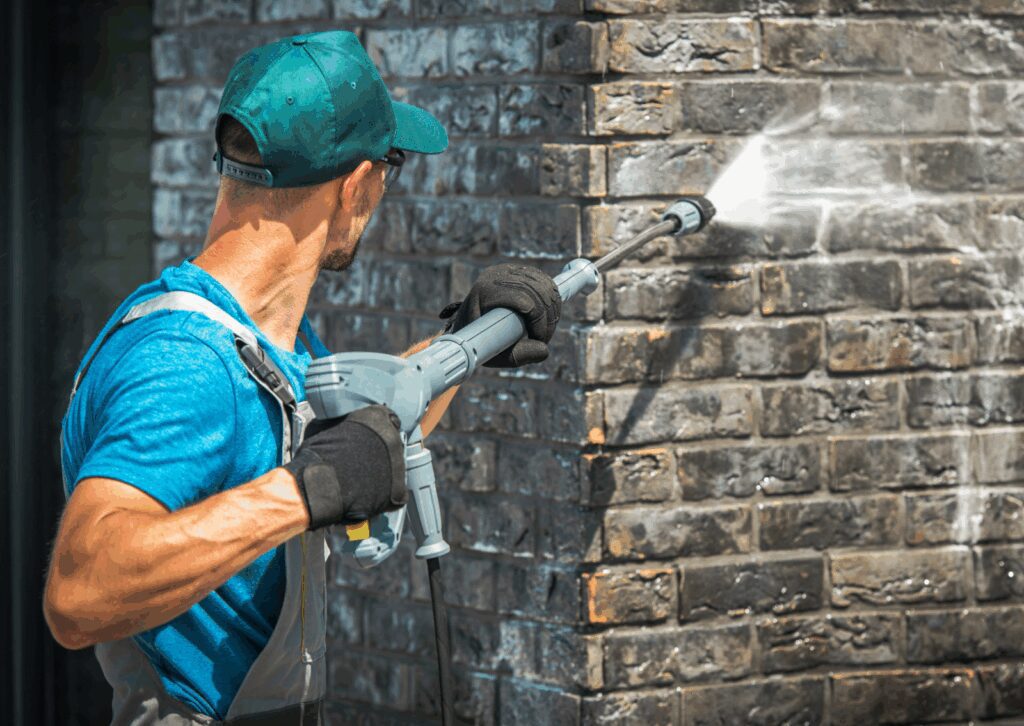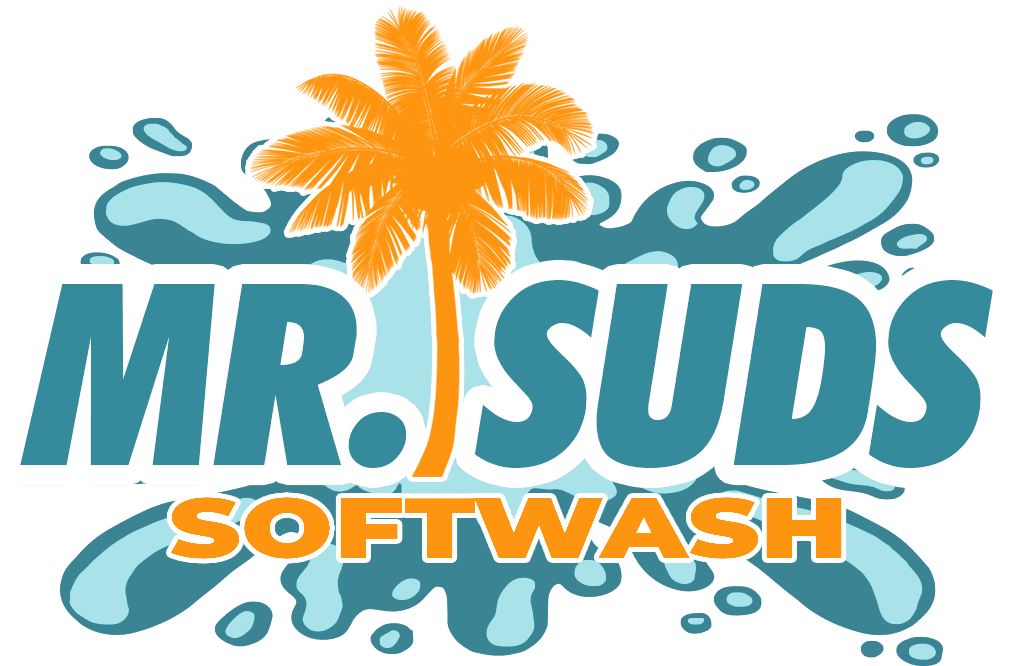When it comes to keeping your home’s exterior clean and well-maintained, we know the struggle. Over time, dirt, mold, mildew, algae, and even insect nests like mud daubers start to build up on your siding, roof, and other surfaces. These aren’t just unsightly, they can eat away at your materials and reduce the life of your paint and roofing. That’s why we believe every homeowner should understand how to soft wash a house the right way. In this guide, we’ll walk you through a safe, effective, and easy-to-follow cleaning method that won’t damage your landscaping, siding, or plants. We’re drawing on knowledge from our experience and companies like Mr. Suds Softwash to bring you a reliable plan that works.
What Is Soft Washing and How Does It Differ from Pressure Washing?

Soft washing is a safer alternative to traditional pressure washing. It uses a low-pressure pump to apply a specially formulated cleaning solution to your home’s exterior, breaking down grime, algae, and mildew. Unlike a pressure washer, which can apply up to 3000 PSI of force and damage surfaces, soft washing typically runs under 100 PSI. That’s gentler than your garden hose on full blast.
The biggest difference is cleaning power. While power washing relies on brute force and high pressure, soft washing uses chemicals, usually a mix of sodium hypochlorite, surfactant, and water, to do the heavy lifting. This approach is especially important for delicate surfaces like painted siding, wood trim, or aging roof shingles.
Why Should Homeowners Learn How to Soft Wash a House Properly?

Learning how to soft wash a house helps prevent costly damage to your siding, landscaping, and roofing materials. High-pressure cleaning methods can break seals, blow off paint, or even puncture vinyl siding. But when done correctly, soft washing keeps your house looking sharp, removes biological growth, and helps your paint last longer.
It’s also safer for you and your plants. If you don’t want to hire professionals every season, learning this process is a great idea. The chemicals used, such as bleach, need to be used with caution, so you’ll want to be careful and follow safety procedures..
What Equipment Do You Need to Soft Wash a House Safely?

To perform a soft wash, you’ll need the right system. Here’s a simple breakdown:
- Low-pressure pump or modified pressure washer with a soap nozzle
- Garden hose with a rinse nozzle
- A pump sprayer or downstream injector
- Scrub brush for stubborn areas
- Surface cleaner (optional for flat surfaces like driveways)
- Safety gear: gloves, goggles, respirator
This cleaning method doesn’t require expensive gear. You can often modify a pressure washer with the right tip to simulate a soft wash system, but keep it under 100 PSI to avoid surface damage.
What Cleaning Solution Works Best for a House Wash?

The standard recipe used by companies like Mr. Suds Softwash includes a blend of:
- Sodium hypochlorite (12.5% bleach)
- Water
- Dish soap or a professional-grade surfactant
This mix breaks down mold, algae, and organic stains without needing high pressure. Most pros use a 3:1 or 4:1 ratio of water to bleach. For example, 3 gallons of water to 1 gallon of bleach, with a few ounces of soap for cling and foaming.
Always test your solution on a small area and adjust your dwell time, how long the cleaning solution sits on the surface, depending on how dirty the area is.
How Does a Soft Wash System Protect Your Home’s Exterior?

A proper soft wash system applies just enough pressure to coat the surface without blasting it. This is vital for areas like painted siding, wood trim, and older roofing where high pressure could break or strip away materials.
Additionally, soft washing kills spores and microbes, giving it longer-lasting results compared to pressure washing alone. With the right cleaning solution, even deeply rooted mold and algae can be eliminated at their source.
How Can You Prepare Your Home and Landscaping Before the Wash?

Before you begin your house wash, take the following precautions:
- Rinse down plants and cover delicate flowers with plastic
- Close windows and doors
- Move outdoor furniture and grills
- Shut off outdoor electrical outlets
- Use your garden hose to wet down landscaping both before and after applying the solution
By rinsing your plants and keeping them wet, you can prevent damage from bleach overspray. Remember: be careful, especially on windy days when chemicals might drift.
What’s the Step-by-Step Process for a Safe and Effective House Wash?

- Begin by soaking your home’s exterior with water to cool the surfaces and prep for the cleaning solution
- Use your low-pressure pump to apply the soft wash mix starting from the bottom up
- Allow for proper dwell time, about 10-15 minutes
- Agitate stubborn areas with a brush or scrub brush
- Rinse thoroughly from top down using your garden hose or low-pressure setting
If you see stains or grime remaining, repeat the process. This approach works great for vinyl, stucco, roof shingles, and more.
What Surfaces Should You Soft Wash and Which Require Extra Caution?

You can safely use soft washing on:
- Vinyl siding
- Brick
- Asphalt roof shingles
- Painted wood
- Composite decks
Use caution on:
- Oxidized paint (chalky surfaces)
- Glass
- Screens
- Aluminum siding
Other surfaces, like decorative stone or cedar, should be spot-tested. Always read column headers on chemical containers for compatibility before sprayed application.
Can You Use a Pressure Washer for Soft Washing Or Should You Avoid It?

A traditional pressure washer isn’t designed for soft washing, but it can be modified. Attach a downstream injector or use a chemical tip to reduce pressure. That said, it’s easy to make a mistake and apply too much force.
Many homeowners confuse power washing and soft washing, but they are not the same. High pressure should never be used on roofs or painted siding. If unsure, it’s better to rent a soft wash system or call Mr. Suds Softwash for guidance.
What Common Mistakes Should You Avoid When Soft Washing a House?

Avoid these errors:
- Letting the cleaning solution dry on surfaces (can cause streaks)
- Not pre-wetting plants
- Using too strong a mix of bleach
- Holding the wand too close to delicate materials
- Not giving enough dwell time
- Forgetting to flush your pump after use
Using dish soap instead of a proper surfactant can also reduce effectiveness, especially on tough grime or mildew.
How Can You Ensure the Cleaning Method Is Safe for Pets, Plants, and Paint?

Keep pets indoors, rinse off toys, and always rinse plants with clean water before and after the job. Don’t use a strong bleach mix near garden beds. Watch the ratio, and wear gloves when handling chemicals.
Also, keep painted surfaces wet during the process to prevent spotting, and avoid hot days when the solution can dry too fast. A simple garden hose rinse can make a huge difference in protecting your landscaping.
What Are Some Other Topics Homeowners Should Know About Exterior Cleaning?

Here are a few other topics that often come up:
- How often should you clean? Once a year is usually enough.
- Can you combine soft and pressure washing? Yes, for things like driveways or fences.
- What about warranties? Some roof warranties require soft washing instead of power washing.
Proper cleaning protects your house from decay and adds value. It’s a smart part of home maintenance that many overlook.
What Are the Benefits of Hiring Professionals for the Job?

Doing it yourself is possible, but hiring professionals like Mr. Suds Softwash offers:
- Proper gear and cleaning solution
- No risk of damaging your siding or plants
- Faster turnaround with better results
- Insurance and satisfaction guarantees
This kind of job takes skill, especially when working on a roof or multi-story house. For peace of mind, bring in the pros if you’re not fully confident.
Ready to Restore Your Home’s Exterior the Safe Way?

Don’t let stains, grime, and algae take over your home’s exterior. A professional house wash doesn’t just make your house look good; it extends the life of your materials and helps you avoid costly repairs.
If you’re ready to begin, contact a trusted team that knows how to soft wash a house the right way. Get in touch with experts who understand ratio, surfactant blends, and how to get the job done without damaging your plants, paint, or roof.
Schedule your soft wash today with Mr. Suds Softwash and experience the difference professional care can make. Book a quote now and let your house shine again, without the risk.
Works Cited
- Clark, Jessica. Exterior Cleaning Methods for Homes. Better Homekeeping Press, 2021.
- Whitmore, Sam. “The Science Behind Soft Washing.” Home Exterior Monthly, vol. 18, no. 4, 2022, pp. 34–39.
- Johnson, Brian. “Pressure Washing vs. Soft Washing: What You Need to Know.” Homeowners Digest, www.homeownersdigest.com/pressure-vs-soft. Accessed 28 May 2025.
- Garcia, Linda. Safe Chemical Use in Residential Cleaning. CleanTech Books, 2020.
- Green Building Supply. “Is Sodium Hypochlorite Safe for the Environment?” Green Cleaning Today, www.greenbuildingsupply.com/articles/sodium-hypochlorite-safety. Accessed 28 May 2025.
Final Thoughts
We understand that keeping your home clean without causing damage can be a challenge. But with the right cleaning method, tools, and solution, you can restore your house’s appearance and protect your landscaping. Whether you decide to take on the task yourself or call in a professional like Mr. Suds Softwash, the key is to do it the safe, smart way.
Frequently Asked Questions:
What is the difference between soft washing and pressure washing?
Soft washing uses a low pressure pump and a cleaning solution—typically a blend of sodium hypochlorite, surfactant, and water—to gently clean surfaces without damage. In contrast, pressure washing relies on high pressure to remove dirt but can damage delicate surfaces like siding, paint, and plants.
What surfaces can I safely soft wash around my home?
You can safely soft wash vinyl siding, painted wood, asphalt shingles, brick, and even roofs. Always be cautious with oxidized paint, glass, and sensitive plants, and test your solution on a small area first to avoid damage.
Can I use my pressure washer for soft washing?
Yes, but only if it’s modified with the correct tip or injector to reduce pressure. A traditional pressure washer is not designed for soft washing, and using high pressure can easily break or damage your home’s exterior.
What’s the best cleaning solution for soft washing a house?
A standard recipe includes a 3:1 or 4:1 ratio of water to sodium hypochlorite, plus dish soap or a professional surfactant. This mix is effective for removing mold, algae, and grime without harming your materials, when applied correctly with a low-pressure pump.
How do I protect my plants and landscaping while soft washing?
Before applying any cleaning solution, wet your plants with a garden hose to create a protective barrier. After rinsing your home's exterior, rinse the plants again to remove any chemical residue. For extra protection, cover delicate landscaping with plastic sheeting.

